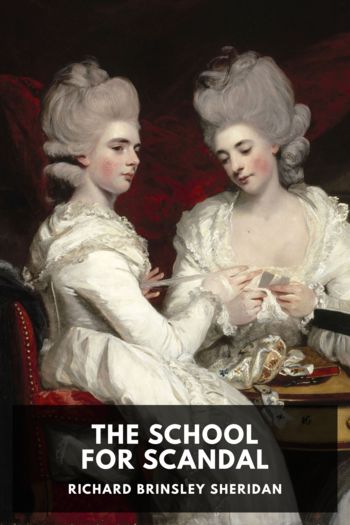Malaysian Maverick: Mahathir Mohamad in Turbulent Times Barry Wain (grave mercy .TXT) 📖

- Author: Barry Wain
Book online «Malaysian Maverick: Mahathir Mohamad in Turbulent Times Barry Wain (grave mercy .TXT) 📖». Author Barry Wain
Some of the Southeast Asian resentment against Dr. Mahathir surfaced after he sacked and jailed his deputy, Anwar Ibrahim, in 1998. Joining predictable Western outrage, the leaders of Indonesia and the Philippines criticized Dr. Mahathir, and Thailand expressed concern. Cory Aquino, a former Philippine president who carried considerable moral authority, also rebuked him, while regional newspapers, non-governmental organizations and commentators denounced his conduct in unprecedented fashion.
In the United States, where Dr. Mahathir was already notorious for blaming "rogue speculators" led by George Soros for the Asian economic crisis, President Bill Clinton's administration treated him as a virtual pariah. Deputising for Clinton at an APEC summit in Kuala Lumpur in November 1998, Vice President Al Gore infuriated his hosts by publicly backing Anwar's Reformasi movement. Dr. Mahathir continued to attract adverse publicity over currency controls, Anwar's trials and a crackdown on political opponents. "September 11" rescued him. After terrorists crashed hijacked aircraft into the World Trade Centre in New York and the Pentagon in Washington on 11 September 2001, President George W. Bush, who had been reluctant to meet Dr. Mahathir, embraced Malaysia as a partner in his "war on terror".
What Bush did not know was that Dr. Mahathir, at the height of his unpopularity over Anwar, had decided it was time to mend fences with Washington. Mahathir associates secretly paid US$1.2 million to American lobbyists to arrange the rapprochement, the money being channeled through the well-connected Jack Abramoff, who was subsequently jailed for improperly influencing members of Congress and their aides.[137] Only when scandal engulfed Abramoff years later did it become known that he was being paid by the Malaysian embassy in Washington, and that some of the funds went to analysts in the United States writing favourable commentaries about Malaysia. Kuala Lumpur also won points by cooperating with U.S. authorities in passing on intelligence about some of the "September 11" hijackers who had passed through Malaysia and others with al-Qaeda connections. The outcome was a meeting in Washington in 2002 between Dr. Mahathir and Bush, which both sides sought, as Dr. Mahathir made his first visit to the United States in eight years.
In their three-hour session, Bush did not mention Anwar's mistreatment, and he later praised Dr. Mahathir for his strong support in combating terrorism. The president hailed Malaysia as "a modern, moderate and prosperous Muslim state", and "an important example to the region and the rest of the world".[138] Bush obviously hoped Dr. Mahathir, who was to chair both the Non-Aligned Movement and the OIC, beginning in 2003, would help swing moderate Muslims behind Washington's anti-terrorist campaign.
It did not work out like that. As the United States-led forces attacked Iraq in early 2003, Dr. Mahathir slipped back into his anti-American rhetoric, describing the superpower as a "cowardly and imperialist" bully[139] that was using "September 11" as an excuse to attack Muslim nations.[140] He deeply angered the Americans by referring to victims of the September 11 attacks and the Bali bombing in October 2002 as collateral damage.[141] The vitriolic denunciations persisted, becoming ever more shrill and "going beyond normal expressions of opposition", as a senior American official put it, until Dr. Mahathir retired later in the year.[142]
With Dr. Mahathir's departure and the installation of Abdullah Badawi in 2003, the tone of Malaysia's relations with the United States, Australia and Singapore changed overnight. Abdullah made arrangements to visit the three countries, signalling an end to the open hostility and giving Dr. Mahathir another reason to feel betrayed by his successor. Dr. Mahathir complained to a friend that Abdullah had "completely" reversed his policy towards Washington, Canberra and Singapore.[143] A significant by-product of Kuala Lumpur's about-face was the inclusion of Australia and New Zealand in regional councils. Their prime ministers were invited to the annual ASEAN Summit in 2004, and ASEAN asked them to resume talks on the long-delayed free-trade area.[144] Moreover, Australia and New Zealand, along with India, were included in the line-up for the inaugural East Asia Summit in 2005. Dr. Mahathir was still protesting their inclusion when it opened in Kuala Lumpur.
Notes
Interview with Mahathir Mohamad, 14 August 2007.
Ibid.
Ibid.
Kim Richard Nossal and Richard Stubbs, "Mahathir's Malaysia: An Emerging Middle Power?", in Andrew Cooper, ed., Niche Diplomacy: Middle Powers after the Cold War (Houndmills: Macmillan Press, 1997), pp. 147-163.
Johan Saravanamuttu, "Iconoclasm and Foreign Policy — The Mahathir Years", in Bridget Welsh, ed., Reflections: The Mahathir Years (Washington: Southeast Asia Studies Program, The Paul H. Nitze School of Advanced International Studies, Johns Hopkins University, 2004), p. 307.
John Funston, "Australia-Malaysia Relations: A Maturing Partnership", in Zaniah Marshallsay, ed., Australia-Malaysia Relations: New Roads Ahead (Clayton: Monash Asia Institute, 1996), p. 91.
Shamsul A.B., "Australia in Contemporary Malaysia's Worldview", in Australia-Malaysia Relations, p. 70.
John Funston, "Australia-Malaysia Relations: A Maturing Partnership", p. 91.
Joseph Liow, "Personality, Exigencies and Contingencies: Determinants of Malaysia's Foreign Policy in the Mahathir Administration", in Ho Khai Leong and James Chin, eds, Mahathir's Administration: Performance and Crisis in Governance (Singapore: Times Books International, 2001), p. 157.
Ibid., p. 154.
Joseph Chinyong Liow, The Politics of Indonesia-Malaysia Relations: One Kin, Two Nations (London and New York: RoutledgeCurzon, 2005), p. 134.
Hajrudin Somun, The Secret of the Malaysian Success (Subang Jaya: Pelanduk Publications (M) Sdn. Bhd., 2003), p. 176.
Email correspondence, 25 July 2008, with





Comments (0)